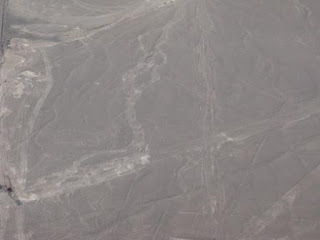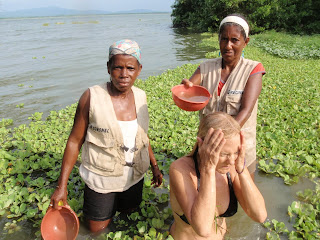Sometimes gifts come in unexpected ways. Yesterday, Christmas Eve, Chris and I, accompanied by our friends and traveling companions, left Puno, Peru after a great visit to the floating islands of the Aymara-speaking Uros indigenous people on Lake Titicaca, which by the way, is shared between 2 countries…at 12,500 feet, Lake Titicaca is 60% in Peru and 40% in Bolivia.
When we stepped up to the desk of Bolivian customs to register the motorcycle, Alberto, the strong-willed gentleman behind the desk, began to question the fact that we only had a photocopy of the registration for the bike, not the original. Graham and Sue had passed through successfully, so we smiled and expected that our persuasive nature would be no problem. It wasn’t so. Alberto stood fast, insisting that since the photocopy could be altered, he could not be sure that the bike was really ours. No amount of pleading, reasoning, or invoking the name of Santa Claus would persuade him. So, we had no choice but to turn back. This meant that we would have to re-enter Peru, less than ¼ mile away, and also to separate from our group and spend Christmas Eve alone. This was bad enough….but when we went to re-enter Peru, we were told that we could not re-enter for 24 hours. By this time it was 2pm on Christmas Eve. Sleeping on the ground outside of customs was not an option. Luckily, when waiting for Chris to exit the bike from Peru, I had been chatting with some of the guys from Peruvian immigration, nice and friendly folks who were very interested in our trip, and where we had been. When the customs folks gave us a hard time, I asked for my buddy Alejandro, who helped us through. We were only allowed to go 2 km to the next town, a tiny little pueblo called Yungonyo, just next to the border.
The only game in town was a small hostel called Hostal Isabel, which had small, smelly rooms with bad windows that let in the freezing-cold breeze. Trying to make the best of it, we began chatting with the owner of the hotel, who told us that there was an 8pm mass at the nearby church, where 85 children would sing Christmas carols. We stopped in at a local market, where Quechua women in their brightly-colored clothes and top-hats, children wrapped in multicolored blankets on their backs, were buying sugar and other supplies for Christmas dinner. The owner of the little shop went into the back and emerged with a great bottle of Chilean Cabernet, which we promptly scrounged up enough soles to buy. Armed with our vino, we found a local restaurant and sat down for Christmas dinner with some of the local folks. Two Quechua ladies, a mother of about 80 and her daughter, sat near us. The mother, her wizened brown face and bright clothes lit up by a sweet smile, took a shine to us. We invited them to share a glass of wine with us and wished them a Feliz Navidad. They took the glasses of wine and as is customary, spilled a few drops onto the floor as an offering to Mother Earth. The start of a great Christmas.
We then went to the church and listened to the children sing. 85 kids dressed in Santa hats, with their indigenous parents hovering around proudly, singing in Spanish. A truly magical sight. They then started a procession out of the church, with everyone following, and we passed through the town singing Christmas Carols, Chris and I the only (obvious) blond gringos, embraced by these lovely people, who shared Pan de Pascua, or Christmas bread with us. The hostel was so cold that we slept in our hats and gloves, and the next morning at 7am headed for the border. We passed through Peru with no problem, greeting our friends from the day before, and when we arrived at Bolivian customs realized that they did not open until 8. Dying for coffee, we stopped in the little bodega across from customs but the gentleman there said they did not have coffee. Five minutes later he came to find us. He had set up a small table in his store, his wife made us café con leche, the best ever, with cinnamon and cloves, and after this feast we found that the shift change at Bolivian customs meant that there was a new guy in charge who accepted our documents without question……….truly a blessing, and what could have been a bad experience turned out to be a real gift of kindness and sharing.
We rejoined our friends in Copacabana, Bolivia, just across the border, and have celebrated Christmas looking at the lake and drinking great wine with Judy and Johannes and Gino.
It doesn’t get any better. But wait, let me go back…..
Since Colombia, we have gone to Ecuador where we spent a few days in Quito, in the old part of the city, and traveled to Mitad del Mundo, on the Equator, where you can actually have one foot in the Southern Hemisphere and one foot in the Northern Hemisphere.
From there, I went to meet my friend Ellen for a brief trip to Chile, with some time in Santiago, wine country and Easter Island. How to describe it?
An amazing respite from the bike trip, with a wonderful friend, adventures exploring the island of Rapa Nui, hiking in the rain, swapping stories, sharing great wine, re-connecting with family and old friends in Santiago, and creating amazing memories…this is in addition to the fact that when speaking with Ellen before her departure from New York, she asked if there was anything she could bring to me for the vacation. After 7 months in motorcycle boots, I answered without hesitation, “A dress and a pair of heels.” So…..armed with her loaned black dress and strappy Prada sandals, we took Santiago by storm. God bless girlfriends.
Back on the bike, I met up with Chris in Lima, Peru, and from there we went to Nazca. Just south of Lima, on the only main road, we encountered some protests which closed the highway.
Protesters were on the hillsides, hurling rocks and other objects at the riot police below, with the police opening fire and ultimately letting off tear gas to stop the unrest. We were stopped a few feet from the action, waiting, and were approached by a cameraman and reporter form Panamericana TV, who asked us for an interview.
Surrounded by our new friends, the riot police, shields and helmets in tow, we gave an interview trying to be as impartial as possible and to not take a position either way. Whew. Finally arriving in Nazca, we re-connected with our traveling buddies and boarded a small plane to see the famous Nazca Lines, which are only visible by air.
The Nazca Lines cover about 500 square kilometers of desert, and are a network of over 800 lines, 300 geoglyphs and 70 animal and plant drawings.
An amazing piece of history, supposedly made by removing sun-darkened stones from the surface of the desert. This exposed the lighter ground below and formed the lines. It is believed that this work was done by the Nazca people from 900 BC to 600 AD.
Aside from the bumpy plane ride and the ensuing airsickness, we really enjoyed this marvel.
From Nazca we headed to Cuzco, stopping one night in a small town along the way. The ride saw us climbing higher and higher into the altiplano, and I suffered some major altitude sickness, mostly drowsiness, and felt myself falling asleep on the back of the bike. This stopped when we encountered some heavy rain, which turned to hail, which turned to big chunks of ice which collected on the highway, causing the bike to slip and slide, fishtailing all over the road. Chris did an amazing job of keeping us upright; good because there was absolutely no town in sight. Freezing, wet, we just kept hoping for a town, anywhere to stop and get something hot to drink. We finally came upon a town and unbelievably, when we stopped for coffee, ran into some of our friends. They came up with sweaters, long-johns, Diamox (altitude-sickness medication) and lots of good cheer, which helped us to soldier on.
The next day we arrived in Cuzco, a beautiful colonial town, where we were able to re-group and plan our trip to Machu Picchu. First, though, Chris, Gino and I hiked up frcm Cuszo to view the amazing ruins of Saqsaywaman. Meaning "Satisfied Falcon" these ruins, which cover 2km and are easily accessible, are an amazing work of the Incas......you wonder how they cut these huge stones and stacked them so perfectly that they still stand today, in perfect order (except for what was looted from the Spaniards to build their churches and homes.)
We were picked up at 6am to board a van and then a train to Machu Picchu. What can I say? Machu Picchu was something out of this world.
When we arrived the entire place was shrouded in fog; disappointing, worrisome, but it eventually lifted, offering amazing vistas. We had organized an English-speaking guide, and got Horacio, whose English was somewhat questionable, but who provided us with lots of laughs. After making a point, every time, his line was “Take the idea?” After hearing this about 20 times it became a point of uncontrollable laughter, and lots of fun. His other famous lines, when speaking about the Incas, was “no water, no life” and “snake, jaguar, condor” speaking about the importance of animal life to the Incas.
After a few lovely days in Cuzco, on to Puno, then to the border, and here we are. Next on to La Paz, Bolivia. The adventure continues.....





































































